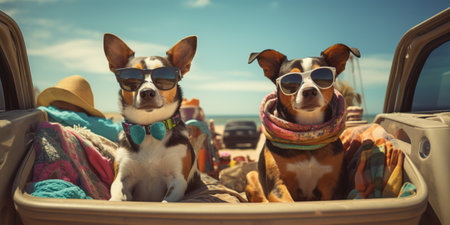1. Common Reasons Dogs Dislike Harnesses
Not all dogs take to wearing a harness right away. Some may resist, act uncomfortable, or even try to escape when you attempt to put one on them. Understanding the reasons behind their hesitation can help you address their concerns and make the experience more positive.
Discomfort and Poor Fit
A harness that doesnt fit properly can be uncomfortable for your dog. If its too tight, it may cause chafing or restrict movement. On the other hand, a loose harness might rub against their skin or make them feel insecure.
| Fit Issue | Possible Problem | Solution |
|---|---|---|
| Too Tight | Can cause chafing, restrict movement, or put pressure on sensitive areas. | Ensure you can fit two fingers between the harness and your dog’s body. |
| Too Loose | The harness may slide around, causing discomfort or making it easy for the dog to slip out. | Adjust straps so the harness stays snug without being restrictive. |
| Poor Design | Certain materials or designs may irritate your dogs skin or fur. | Select a padded or breathable harness suited to your dogs breed and coat type. |
Negative Past Experiences
If a dog has had a bad experience with a harness in the past—such as being forced into one abruptly or feeling pain while wearing it—they may develop an aversion to it. Dogs with a history of trauma or those who associate the harness with unpleasant events (like vet visits) may react negatively.
Signs Your Dog May Have Had a Bad Experience
- Cowering or backing away when they see the harness.
- Tucking their tail between their legs.
- Panting or excessive licking when wearing it.
- Tense body language or trying to escape.
Sensitivity to Touch
Some dogs are naturally sensitive to touch, especially around certain areas like their legs, chest, or back. The process of putting on a harness—especially if it requires lifting their legs—can make them anxious or uncomfortable.
How to Help Touch-Sensitive Dogs Adjust
- Gradually introduce them to being touched in harness-related areas using treats and praise.
- Avoid sudden movements when putting on the harness.
- Select step-in styles if they dislike things going over their head.
- Treat and reward them for staying calm during the process.
Lack of Exposure
If a dog has never worn a harness before, they might find it strange and unfamiliar. Puppies or rescued dogs who havent been introduced to one gradually might react by resisting or trying to get out of it.
Ways to Introduce a Harness Gently
- Let Them Sniff It: Place the harness near them and allow them to investigate it at their own pace.
- Create Positive Associations: Reward them with treats when they interact calmly with the harness.
- Praise Small Steps: Reward your dog for allowing you to drape the harness over their body before fastening it fully.
- Short Practice Sessions: Start with short periods of wearing the harness indoors before taking them outside with it on.
The key is patience and consistency. By understanding why some dogs resist wearing a harness, you can tailor your approach to help them feel more comfortable and secure while wearing one.
Signs Your Dog Is Uncomfortable in a Harness
Not all dogs take to wearing a harness right away. Some may show clear signs of discomfort, while others might be more subtle about it. Understanding these signs can help you determine if your pup needs extra time and encouragement to adjust.
Common Signs of Discomfort
Dogs communicate through their behavior, and if they dislike their harness, they will likely show it in various ways. Here are some common signs that indicate your dog is uncomfortable:
| Behavior | What It Means |
|---|---|
| Hesitation or Resistance | Your dog may stop moving, freeze up, or back away when you try to put the harness on. |
| Scratching or Biting at the Harness | If your dog constantly scratches or bites at the harness after putting it on, they may find it irritating or restrictive. |
| Avoiding Walks | Some dogs associate the harness with discomfort and may refuse to go on walks or hide when they see it. |
| Excessive Shaking | A dog that frequently shakes after putting on a harness may be trying to “get rid” of the unfamiliar sensation. |
| Panting or Whining | If your dog starts panting heavily or whining after wearing the harness, they could be experiencing stress or anxiety. |
Why Some Dogs React This Way
There are several reasons why a dog might feel uneasy in a harness:
- Poor Fit: A harness that is too tight can cause discomfort, while one that is too loose may feel awkward.
- Lack of Familiarity: If your dog has never worn a harness before, the new sensation might feel strange or restrictive.
- Negative Associations: If your pup had a bad experience with a harness in the past (such as an uncomfortable fit or getting tangled), they might be reluctant to wear one again.
- Sensitivity Issues: Some dogs have sensitive skin or fur that makes wearing a harness uncomfortable.
How to Tell If It’s Just an Adjustment Period
If your dog shows mild signs of discomfort but still allows you to put on the harness and walk normally after a few minutes, they may just need time to get used to it. However, if they consistently resist wearing it or seem distressed every time, its worth considering adjustments to make them more comfortable.
Next Steps
If your dog exhibits any of these behaviors, don’t worry—there are ways to help them feel better in their harness. The key is patience and positive reinforcement. In the next section, we’ll explore methods for making the adjustment process smoother for your furry friend.

3. Choosing the Right Harness for Your Dog
Finding the perfect harness for your dog is essential to ensuring their comfort and helping them adjust to wearing one. A poorly fitting or uncomfortable harness can make your dog resistant to using it. Here’s how to choose the best harness based on size, breed, and activity level.
Consider Your Dog’s Size and Breed
Different breeds have different body shapes, so a harness that fits well on one dog may not work for another. For example, deep-chested breeds like Greyhounds need a different style than stocky breeds like Bulldogs. Use the table below to find a general guide:
| Dog Type | Recommended Harness Style |
|---|---|
| Small Breeds (e.g., Chihuahua, Dachshund) | Soft padded harness with adjustable straps |
| Deep-Chested Breeds (e.g., Greyhound, Whippet) | H-style or Y-shaped harness for a snug fit |
| Brachycephalic Breeds (e.g., Pug, Bulldog) | No-pull harness that avoids pressure on the neck |
| Large Active Breeds (e.g., Labrador, German Shepherd) | No-pull or front-clip harness for better control |
Selecting the Right Fit
A well-fitted harness should be snug but not too tight. You should be able to fit two fingers between the harness and your dog’s body. If it’s too loose, your dog might slip out; if it’s too tight, it could cause discomfort.
How to Measure Your Dog for a Harness
- Neck Girth: Measure around the base of your dogs neck where the collar usually sits.
- Chest Girth: Measure around the widest part of your dogs chest, just behind the front legs.
- Back Length: Some harnesses require back measurements, especially for small breeds.
The Best Harness Features for Comfort
A comfortable harness should have the following features:
- Padded Straps: Helps prevent chafing and discomfort.
- Buckle Placement: Avoids pressure points on sensitive areas.
- Adjustable Straps: Ensures a custom fit as your dog grows or changes weight.
- No-Pull Design (if needed): Helps with training dogs that pull on walks.
Your Dogs Activity Level Matters
The type of harness you choose should also match your dog’s activity level:
| Activity Level | Iideal Harness Type |
|---|---|
| Couch Potato (Minimal Exercise) | A soft, lightweight harness for occasional walks. |
| Avid Walker (Daily Walks) | An ergonomic, padded harness with adjustable straps. |
| Energizer Pup (High Activity/Running) | A secure, breathable sports-style harness. |
Avoid Common Harness Mistakes
- Poor Fit: Always check the size chart before buying.
- Lack of Adjustments: Ensure all straps are properly adjusted for a snug fit.
- The Wrong Material: Choose breathable fabrics for warm climates and weatherproof materials for rainy areas.
Selecting the right harness can make a huge difference in how comfortable your dog feels while wearing it. By considering their breed, activity level, and comfort needs, you can help them adjust more easily and enjoy their walks without stress.
4. Helping Your Dog Adjust to a Harness
Introducing a harness to your dog can take time, especially if they are not used to wearing one. The key is to go slow, use positive reinforcement, and make the experience as stress-free as possible. Follow these steps to help your dog feel comfortable with their harness.
Step 1: Let Your Dog Get Familiar with the Harness
Before putting the harness on, allow your dog to sniff and investigate it. Place it near their favorite resting spot or offer treats when they approach it. This helps create a positive association with the harness.
Step 2: Introduce the Harness Gradually
Start by gently touching your dog with the harness without fastening it. You can drape it over their back for a few seconds while giving them treats and praise. Repeat this process several times until they seem comfortable.
Step 3: Put on the Harness Without Fastening It
Once your dog is okay with having the harness near them, try slipping it on without buckling it. Give them treats and encouragement so they associate wearing it with positive experiences.
Step 4: Fasten the Harness for Short Periods
When your dog seems relaxed, fasten the harness but keep the session short—just a few minutes at first. Reward them with treats and playtime so they stay distracted and happy.
Step 5: Increase Wear Time Gradually
Slowly extend the amount of time your dog wears the harness indoors before heading outside. If they seem uncomfortable, go back a step and proceed more slowly.
Step 6: Use Positive Reinforcement
Treats, praise, and even a favorite toy can reinforce good behavior when wearing a harness. Avoid forcing the harness on if your dog resists—patience is key!
Step 7: Take a Short Walk Indoors
Once your dog is comfortable wearing the harness inside, try taking a short walk indoors before heading outside. This gives them time to adjust in a familiar environment.
Troubleshooting Common Issues
| Issue | Solution |
|---|---|
| Your dog freezes when wearing the harness | Give them time to adjust by letting them wear it for short periods indoors with plenty of rewards. |
| Your dog tries to bite or remove the harness | Redirect their attention with treats or toys and ensure that the fit is comfortable—not too tight or too loose. |
| Your dog refuses to walk after putting on the harness | Praise and encourage movement using treats or their favorite toy to help them associate walking in the harness with positive experiences. |
A Little Patience Goes a Long Way
The key to success is patience and consistency. Every dog adjusts at their own pace, so take things slow and celebrate small victories along the way!
5. When to Seek Professional Help
Sometimes, despite your best efforts, your dog may continue to resist wearing a harness. In these cases, it might be time to seek help from a professional trainer or veterinarian. Understanding when to reach out for expert assistance can make a big difference in your dogs comfort and overall experience.
Signs That Your Dog Needs Professional Help
If your dog exhibits any of the following behaviors consistently, it may be a sign that they need additional support:
| Behavior | Possible Concern |
|---|---|
| Growling, snapping, or biting when the harness is introduced | Your dog may have deep-seated fear or past trauma related to restraints. |
| Panic reactions such as excessive panting, drooling, or trying to escape | The harness may trigger extreme anxiety, requiring desensitization techniques. |
| Refusal to move or complete shutdown after the harness is on | Your dog may associate the harness with negative experiences or discomfort. |
| No improvement despite consistent training and positive reinforcement | A professional trainer can assess if there are underlying behavioral issues. |
| Sensitivity around certain areas of the body when touched | A veterinarian should check for medical conditions causing discomfort. |
Choosing Between a Trainer or Veterinarian
If youre unsure whether to consult a trainer or a vet, consider the root cause of your dogs resistance:
- If your dog shows signs of pain or discomfort: A visit to the veterinarian is crucial to rule out medical issues such as joint pain, skin irritation, or past injuries.
- If your dog displays fear-based reactions: A certified dog trainer or behaviorist can work on confidence-building exercises and gradual desensitization.
- If theres a combination of both: Consulting both professionals ensures your dog gets comprehensive care tailored to their needs.
The Benefits of Seeking Professional Help
A professional can provide personalized guidance tailored to your dogs unique temperament and history. Whether through behavioral modification techniques or identifying physical discomforts, their expertise will help make harness training a smoother process.
Key Takeaways:
- If your dog reacts aggressively, freezes up, or panics with a harness, professional help may be necessary.
- A vet can check for medical concerns, while a trainer can help with behavioral challenges.
- The right approach can ensure your dog feels safe and comfortable wearing a harness over time.
If youve tried everything and your pup still struggles with the harness, dont hesitate to seek expert guidance. With patience and the right support, you can help them feel secure and confident on their walks.


